Repurposing Portable Gas Chromatograph–Mass Spectrometers for Detecting Volatile Organic Compound Biomarkers in Urine Headspace
Abstract
1. Introduction
2. Materials and Methods
2.1. Materials and Instrumentation
2.2. Urine Sample Acquisition and Processing
2.3. Probe-Based Sampling and GC–MS Analysis
2.4. Data Processing and Analysis
3. Results and Discussion
3.1. Optimization of Pretreatment Procedures
3.2. Exploration of Portable GC–MS Parameters
3.3. Benchmarking Intra-Day Reproducibility
3.4. Inter-Day GC–MS Performance
3.5. Interrogating VOC Functionality
4. Conclusions
Author Contributions
Funding
Data Availability Statement
Acknowledgments
Conflicts of Interest
References
- Jendrny, P.; Twele, F.; Meller, S.; Osterhaus, A.D.M.E.; Schalke, E.; Volk, H.A. Canine olfactory detection and its relevance to medical detection. BMC Infect. Dis. 2021, 21, 838. [Google Scholar] [CrossRef] [PubMed]
- Angle, C.; Waggoner, L.P.; Ferrando, A.; Haney, P.; Passler, T. Canine Detection of the Volatilome: A Review of Implications for Pathogen and Disease Detection. Front. Vet. Sci. 2016, 3, 47. [Google Scholar] [CrossRef] [PubMed]
- Moser, E.; McCulloch, M. Canine scent detection of human cancers: A review of methods and accuracy. J. Vet. Behav. 2010, 5, 145–152. [Google Scholar] [CrossRef]
- da Costa, B.R.B.; De Martinis, B.S. Analysis of urinary VOCs using mass spectrometric methods to diagnose cancer: A review. Clin. Mass Spectrom. 2020, 18, 27–37. [Google Scholar] [CrossRef]
- Woollam, M.; Teli, M.; Angarita-Rivera, P.; Liu, S.; Siegel, A.P.; Yokota, H.; Agarwal, M. Detection of Volatile Organic Compounds (VOCs) in Urine via Gas Chromatography-Mass Spectrometry QTOF to Differentiate Between Localized and Metastatic Models of Breast Cancer. Sci. Rep. 2019, 9, 2526. [Google Scholar] [CrossRef]
- Wen, Q.; Boshier, P.; Myridakis, A.; Belluomo, I.; Hanna, G.B. Urinary Volatile Organic Compound Analysis for the Diagnosis of Cancer: A Systematic Literature Review and Quality Assessment. Metabolites 2020, 11, 17. [Google Scholar] [CrossRef]
- Hester, R.E.; Harrison, R.M. Volatile Organic Compounds in the Atmosphere; Royal Society of Chemistry: London, UK, 1995; Volume 4. [Google Scholar]
- Williams, J.; Koppmann, R.J. Volatile organic compounds in the atmosphere: An overview. Volatile Org. Compd. Atmos. 2007, 1, 1–32. [Google Scholar]
- Ninkovic, V.; Markovic, D.; Rensing, M. Plant volatiles as cues and signals in plant communication. Plant Cell Environ. 2021, 44, 1030–1043. [Google Scholar] [CrossRef]
- Amann, A.; Costello, B.d.L.; Miekisch, W.; Schubert, J.; Buszewski, B.; Pleil, J.; Ratcliffe, N.; Risby, T. The human volatilome: Volatile organic compounds (VOCs) in exhaled breath, skin emanations, urine, feces and saliva. J. Breath Res. 2014, 8, 034001. [Google Scholar] [CrossRef]
- Ruszkiewicz, D.M.; Sanders, D.; O’Brien, R.; Hempel, F.; Reed, M.J.; Riepe, A.C.; Bailie, K.; Brodrick, E.; Darnley, K.; Ellerkmann, R.J.E. Diagnosis of COVID-19 by analysis of breath with gas chromatography-ion mobility spectrometry-a feasibility study. eClinicalMedicine 2020, 29, 100609. [Google Scholar] [CrossRef]
- Woollam, M.; Angarita-Rivera, P.; Siegel, A.P.; Kalra, V.; Kapoor, R.; Agarwal, M. Exhaled VOCs can discriminate subjects with COVID-19 from healthy controls. J. Breath Res. 2022, 16, 036002. [Google Scholar] [CrossRef] [PubMed]
- Leemans, M.; Bauër, P.; Cuzuel, V.; Audureau, E.; Fromantin, I. Volatile Organic Compounds Analysis as a Potential Novel Screening Tool for Breast Cancer: A Systematic Review. Biomark. Insights 2022, 17, 11772719221100709. [Google Scholar] [CrossRef] [PubMed]
- Kure, S.; Satoi, S.; Kitayama, T.; Nagase, Y.; Nakano, N.; Yamada, M.; Uchiyama, N.; Miyashita, S.; Iida, S.; Takei, H.; et al. A prediction model using 2-propanol and 2-butanone in urine distinguishes breast cancer. Sci. Rep. 2021, 11, 19801. [Google Scholar] [CrossRef]
- Fink, H.; Maihöfer, T.; Bender, J.; Schulat, J. Indole as a new tentative marker in exhaled breath for non-invasive blood glucose monitoring of diabetic subjects. J. Breath Res. 2022, 16, 026001. [Google Scholar] [CrossRef]
- Siegel, A.P.; Daneshkhah, A.; Hardin, D.S.; Shrestha, S.; Varahramyan, K.; Agarwal, M. Analyzing breath samples of hypoglycemic events in type 1 diabetes patients: Towards developing an alternative to diabetes alert dogs. J. Breath Res. 2017, 11, 026007. [Google Scholar] [CrossRef]
- Phillips, M.; Cataneo, R.N.; Cheema, T.; Greenberg, J. Increased breath biomarkers of oxidative stress in diabetes mellitus. Clin. Chim. Acta 2004, 344, 189–194. [Google Scholar] [CrossRef]
- Janfaza, S.; Khorsand, B.; Nikkhah, M.; Zahiri, J. Digging deeper into volatile organic compounds associated with cancer. Biol. Methods Protoc. 2019, 4, bpz014. [Google Scholar] [CrossRef]
- Woollam, M.; Grocki, P.; Schulz, E.; Siegel, A.P.; Deiss, F.; Agarwal, M. Evaluating polyvinylidene fluoride-carbon black composites as solid phase microextraction coatings for the detection of urinary volatile organic compounds by gas chromatography-mass spectrometry. J. Chromatogr. A 2022, 1685, 463606. [Google Scholar] [CrossRef]
- Boeselt, T.; Terhorst, P.; Kroenig, J.; Nell, C.; Spielmanns, M.; Boas, U.; Veith, M.; Vogelmeier, C.; Greulich, T.; Koczulla, A.R.; et al. Specific molecular peak analysis by ion mobility spectrometry of volatile organic compounds in urine of COVID-19 patients: A novel diagnostic approach. J. Virol. Methods 2024, 326, 114910. [Google Scholar] [CrossRef]
- Nicolier, C.; Künzler, J.; Lizoain, A.; Kerber, D.; Hossmann, S.; Rothenbühler, M.; Laimer, M.; Witthauer, L. Detection of hypoglycaemia in type 1 diabetes through breath volatile organic compound profiling using gas chromatography–ion mobility spectrometry. Diabetes Obes. Metab. 2024, 26, 5737–5744. [Google Scholar] [CrossRef]
- Belluomo, I.; Boshier, P.R.; Myridakis, A.; Vadhwana, B.; Markar, S.R.; Spanel, P.; Hanna, G.B. Selected ion flow tube mass spectrometry for targeted analysis of volatile organic compounds in human breath. Nat. Protoc. 2021, 16, 3419–3438. [Google Scholar] [CrossRef] [PubMed]
- Jia, Z.; Ong, W.Q.; Zhang, F.; Du, F.; Thavasi, V.; Thirumalai, V. A study of 9 common breath VOCs in 504 healthy subjects using PTR-TOF-MS. Metabolomics 2024, 20, 79. [Google Scholar] [CrossRef] [PubMed]
- Bajo-Fernández, M.; Souza-Silva, É.A.; Barbas, C.; Rey-Stolle, M.F.; García, A. GC-MS-based metabolomics of volatile organic compounds in exhaled breath: Applications in health and disease. A review. Front. Mol. Biosci. 2023, 10, 1295955. [Google Scholar] [CrossRef] [PubMed]
- Ghazaly, C.; Biletska, K.; Thevenot, E.A.; Devillier, P.; Naline, E.; Grassin-Delyle, S.; Scorsone, E. Assessment of an e-nose performance for the detection of COVID-19 specific biomarkers. J. Breath Res. 2023, 17, 026006. [Google Scholar] [CrossRef]
- Maciel, M.; Sankari, S.; Woollam, M.; Agarwal, M. Optimization of Metal Oxide Nanosensors and Development of a Feature Extraction Algorithm to Analyze VOC Profiles in Exhaled Breath. IEEE Sens. J. 2023, 23, 16571–16578. [Google Scholar] [CrossRef]
- Binson, V.A.; Akbar, R.; Thankachan, N.; Thomas, S. Design and construction of a portable e-nose system for human exhaled breath VOC analysis. Mater. Today Proc. 2022, 58, 422–427. [Google Scholar] [CrossRef]
- Eckenrode, B.A. Environmental and Forensic applications of field-portable GC-MS: An overview. J. Am. Soc. Mass Spectrom. 2001, 12, 683–693. [Google Scholar] [CrossRef]
- Bussey, R.O., III. Uses of Portable Gas Chromatography Mass Spectrometers. In Novel Aspects of Gas Chromatography and Chemometrics; IntechOpen: London, UK, 2022. [Google Scholar]
- Harshman, S.W.; Rubenstein, M.H.; Qualley, A.V.; Fan, M.; Geier, B.A.; Pitsch, R.L.; Slusher, G.M.; Hughes, G.T.; Dershem, V.L.; Grigsby, C.C.; et al. Evaluation of thermal desorption analysis on a portable GC–MS system. Int. J. Environ. Anal. Chem. 2017, 97, 247–263. [Google Scholar] [CrossRef]
- Aggarwal, P.; Baker, J.; Boyd, M.T.; Coyle, S.; Probert, C.; Chapman, E.A. Optimisation of Urine Sample Preparation for Headspace-Solid Phase Microextraction Gas Chromatography-Mass Spectrometry: Altering Sample pH, Sulphuric Acid Concentration and Phase Ratio. Metabolites 2020, 10, 482. [Google Scholar] [CrossRef]
- Woollam, M. Created in BioRender. 2025. Available online: https://BioRender.com/j01t996 (accessed on 24 April 2025).
- McFarlanE, M.; MozdiaK, E.; Daulton, E.; Arasaradnam, R.; Covington, J.; Nwokolo, C. Pre-analytical and analytical variables that influence urinary volatile organic compound measurements. PLoS ONE 2020, 15, e0236591. [Google Scholar] [CrossRef]
- Seethapathy, S.; Górecki, T. Applications of polydimethylsiloxane in analytical chemistry: A review. Anal. Chim. Acta 2012, 750, 48–62. [Google Scholar] [CrossRef] [PubMed]
- Park, S.; Kim, H.-W.; Joo Lee, C.; Kim, Y.; Sung, J. Profiles of volatile sulfur compounds in various vegetables consumed in Korea using HS-SPME-GC/MS technique. Front. Nutr. 2024, 11, 1409008. [Google Scholar] [CrossRef] [PubMed]
- Woollam, M.; Siegel, A.P.; Munshi, A.; Liu, S.; Tholpady, S.; Gardner, T.; Li, B.-Y.; Yokota, H.; Agarwal, M. Canine-Inspired Chemometric Analysis of Volatile Organic Compounds in Urine Headspace to Distinguish Prostate Cancer in Mice and Men. Cancers 2023, 15, 1352. [Google Scholar] [CrossRef] [PubMed]
- Xu, W.; Zou, X.; Ding, H.; Ding, Y.; Zhang, J.; Liu, W.; Gong, T.; Nie, Z.; Yang, M.; Zhou, Q.; et al. Rapid and non-invasive diagnosis of type 2 diabetes through sniffing urinary acetone by a proton transfer reaction mass spectrometry. Talanta 2023, 256, 124265. [Google Scholar] [CrossRef]
- Rydosz, A. Sensors for Enhanced Detection of Acetone as a Potential Tool for Noninvasive Diabetes Monitoring. Sensors 2018, 18, 2298. [Google Scholar] [CrossRef]
- Rubio-Sánchez, R.; Ríos-Reina, R.; Ubeda, C. Effect of chemotherapy on urinary volatile biomarkers for lung cancer by HS-SPME-GC-MS and chemometrics. Thorac. Cancer 2023, 14, 3522–3529. [Google Scholar] [CrossRef]
- Lima, A.R.; Pinto, J.; Carvalho-Maia, C.; Jerónimo, C.; Henrique, R.; Bastos, M.d.L.; Carvalho, M.; Guedes de Pinho, P. A Panel of Urinary Volatile Biomarkers for Differential Diagnosis of Prostate Cancer from Other Urological Cancers. Cancers 2020, 12, 2017. [Google Scholar] [CrossRef]
- Lima, A.R.; Pinto, J.; Azevedo, A.I.; Barros-Silva, D.; Jerónimo, C.; Henrique, R.; de Lourdes Bastos, M.; Guedes de Pinho, P.; Carvalho, M. Identification of a biomarker panel for improvement of prostate cancer diagnosis by volatile metabolic profiling of urine. Br. J. Cancer 2019, 121, 857–868. [Google Scholar] [CrossRef]
- Woollam, M.; Teli, M.; Liu, S.; Daneshkhah, A.; Siegel, A.P.; Yokota, H.; Agarwal, M. Urinary Volatile Terpenes Analyzed by Gas Chromatography–Mass Spectrometry to Monitor Breast Cancer Treatment Efficacy in Mice. J. Proteome Res. 2020, 19, 1913–1922. [Google Scholar] [CrossRef]
- Patnaik, R.K.; Lin, Y.-C.; Agarwal, A.; Ho, M.-C.; Yeh, J.A. A pilot study for the prediction of liver function related scores using breath biomarkers and machine learning. Sci. Rep. 2022, 12, 2032. [Google Scholar] [CrossRef]
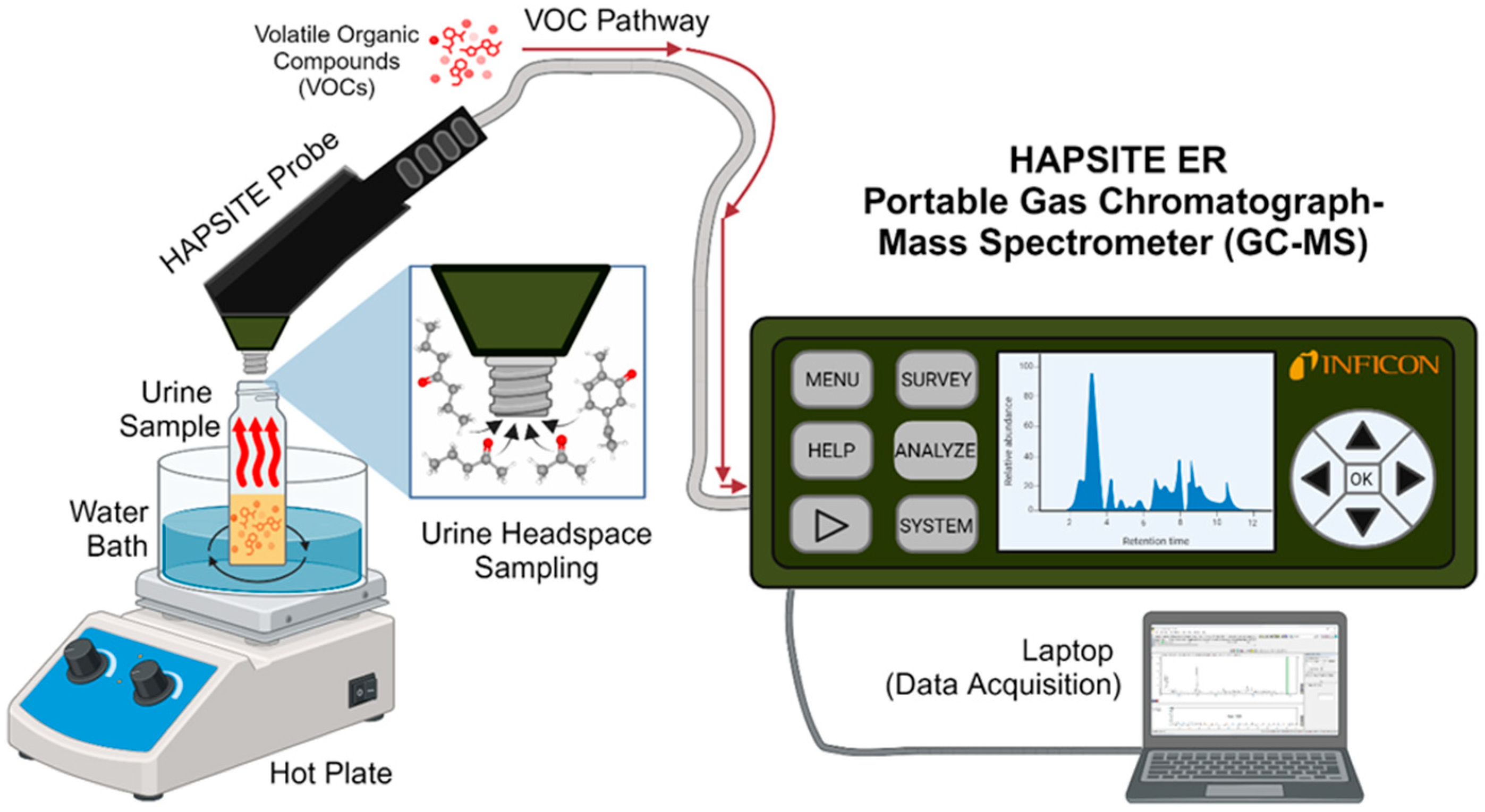
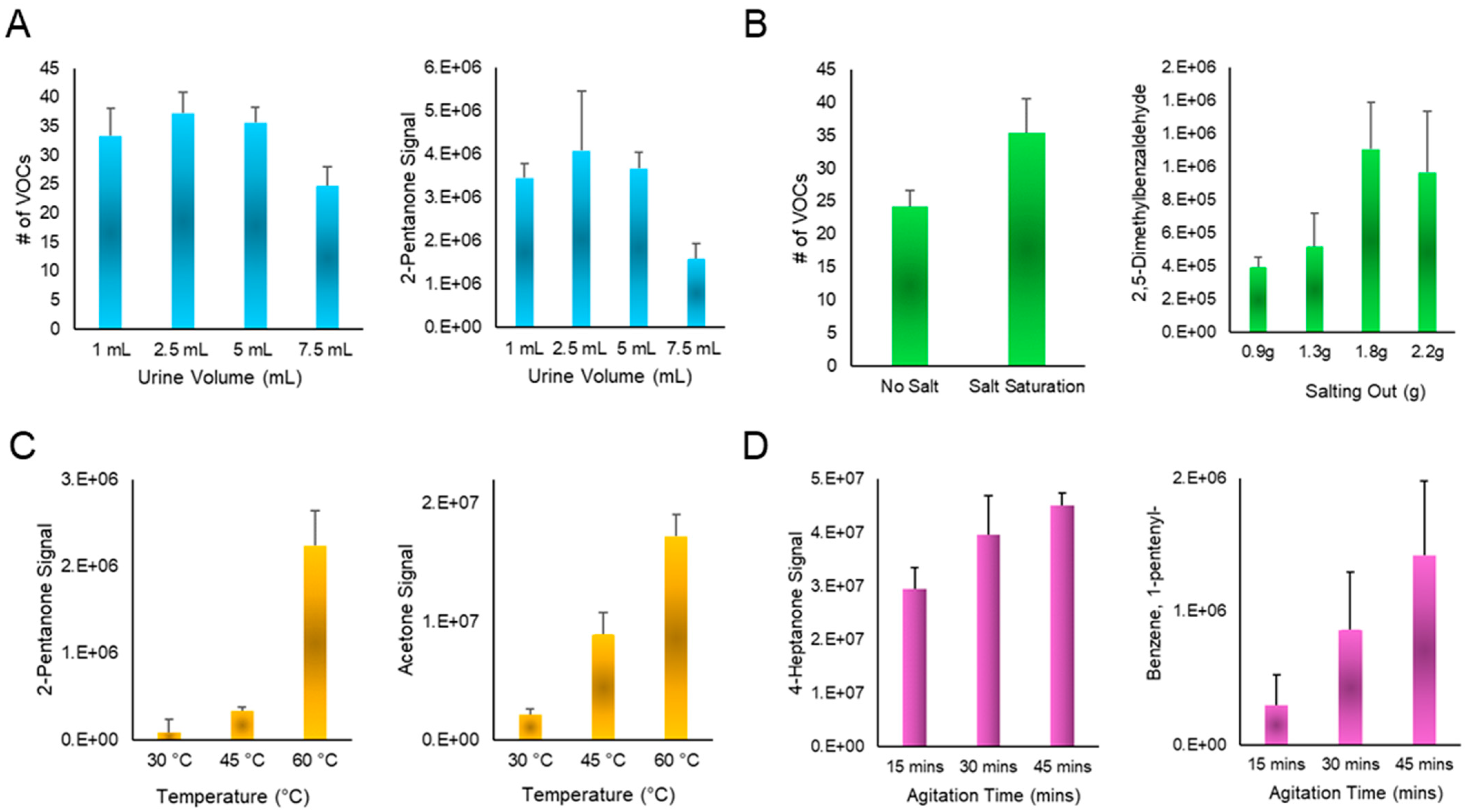
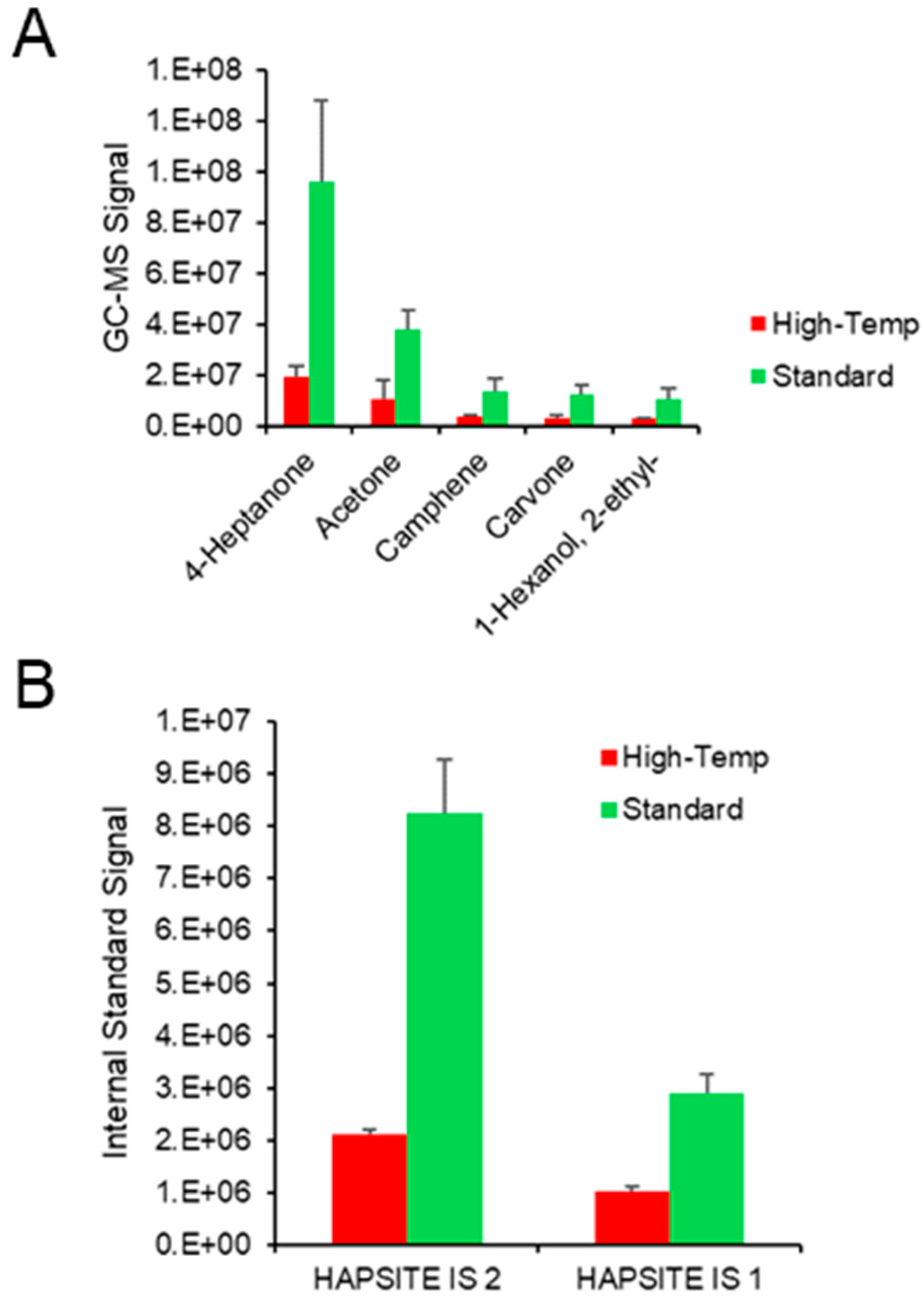
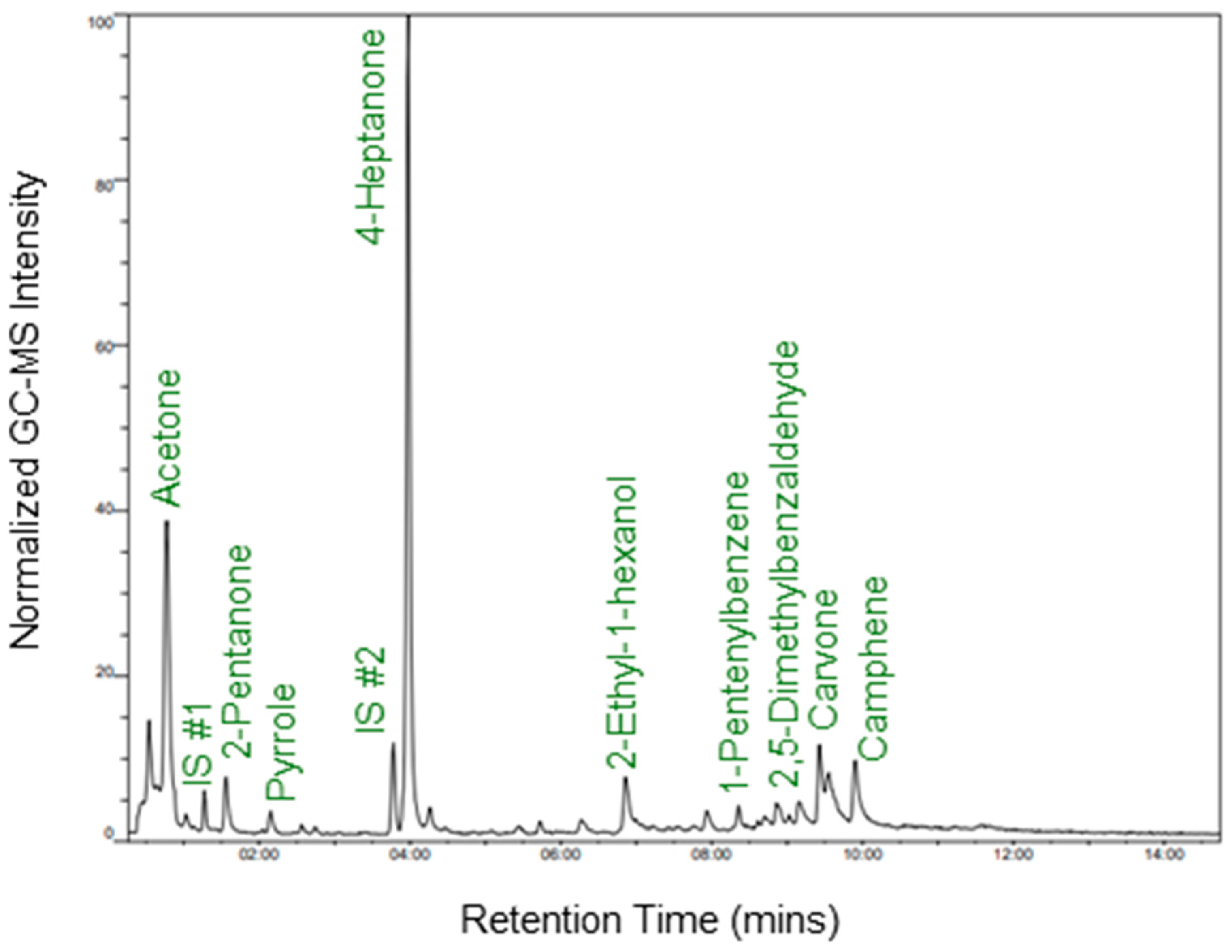
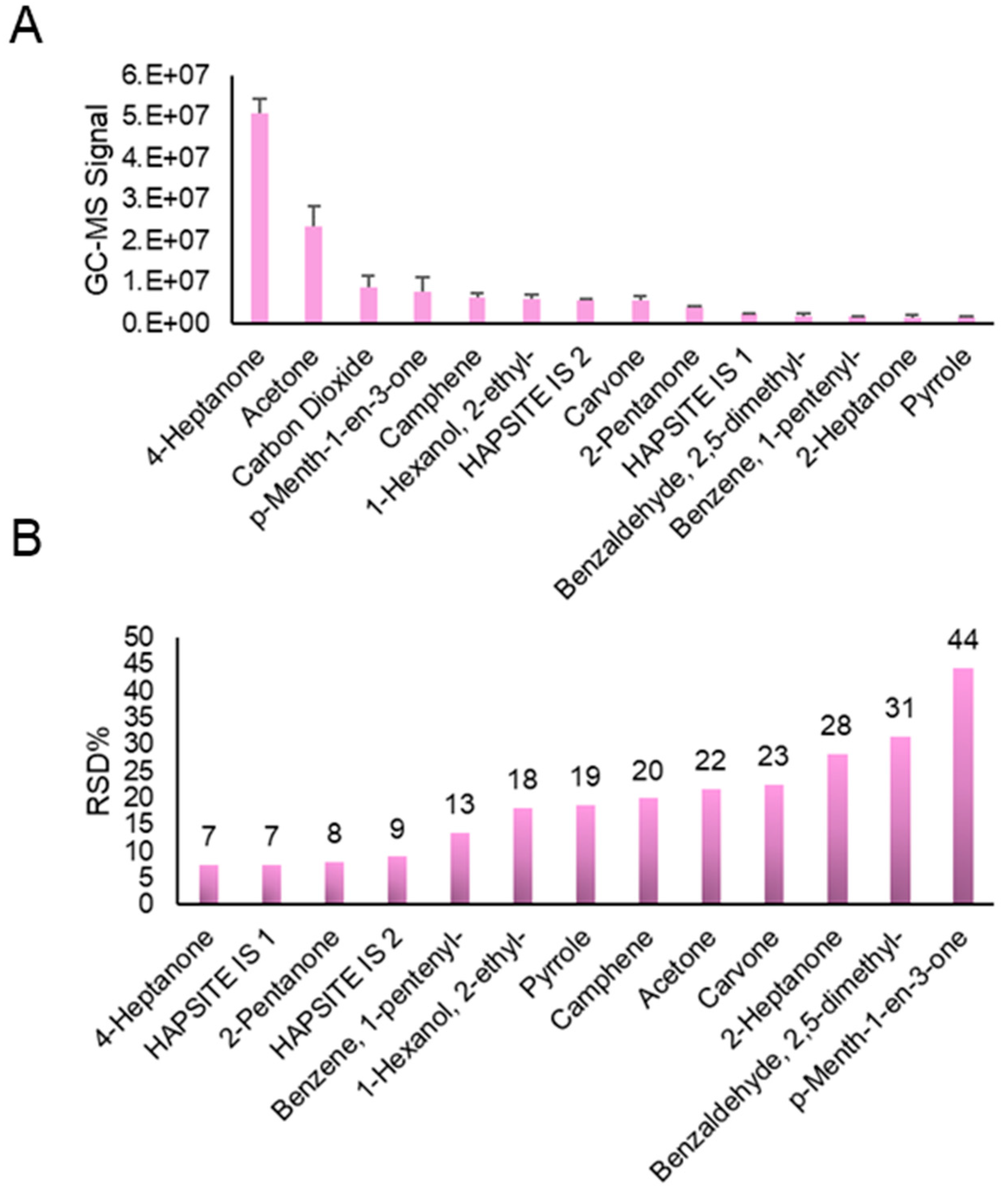
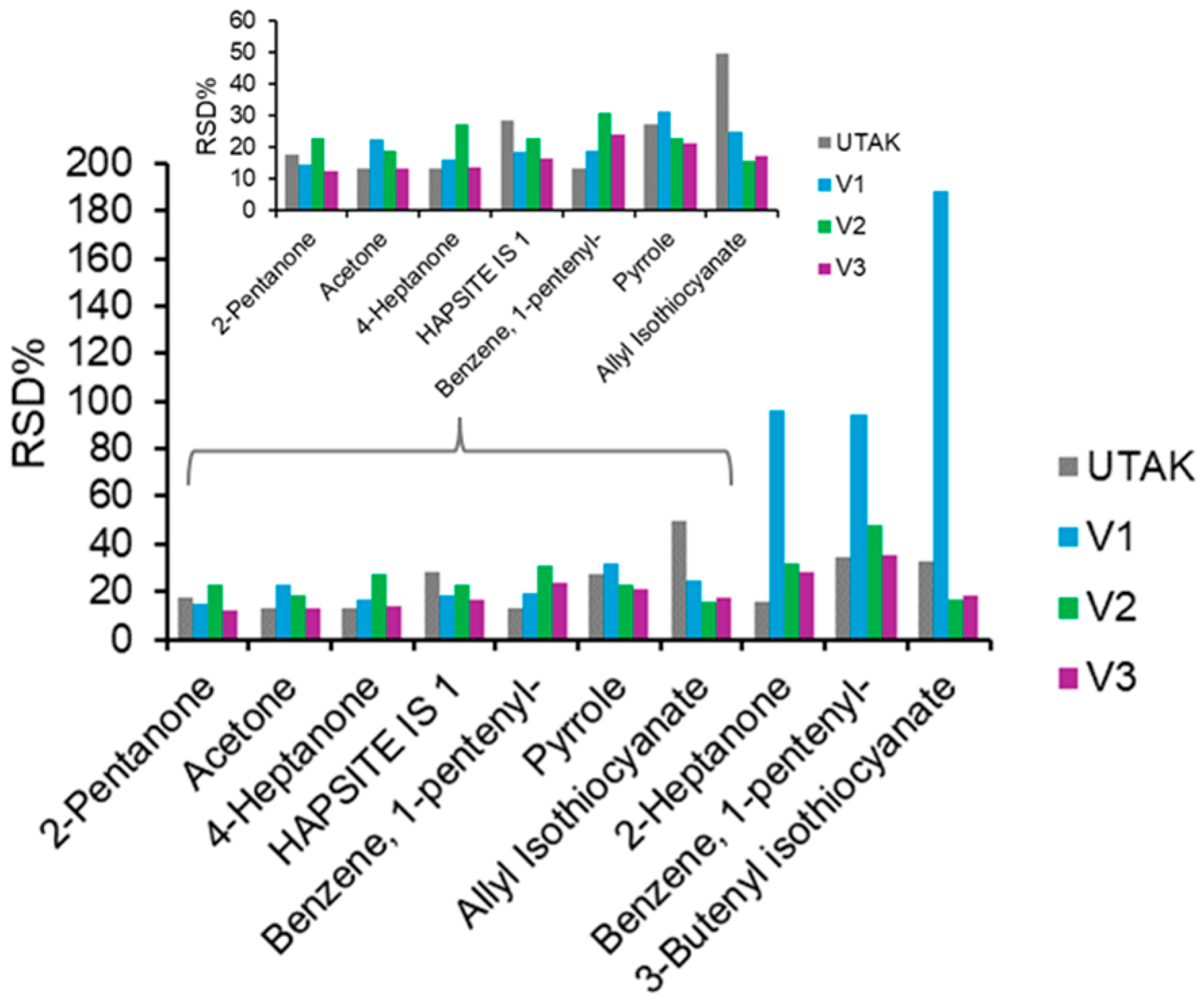
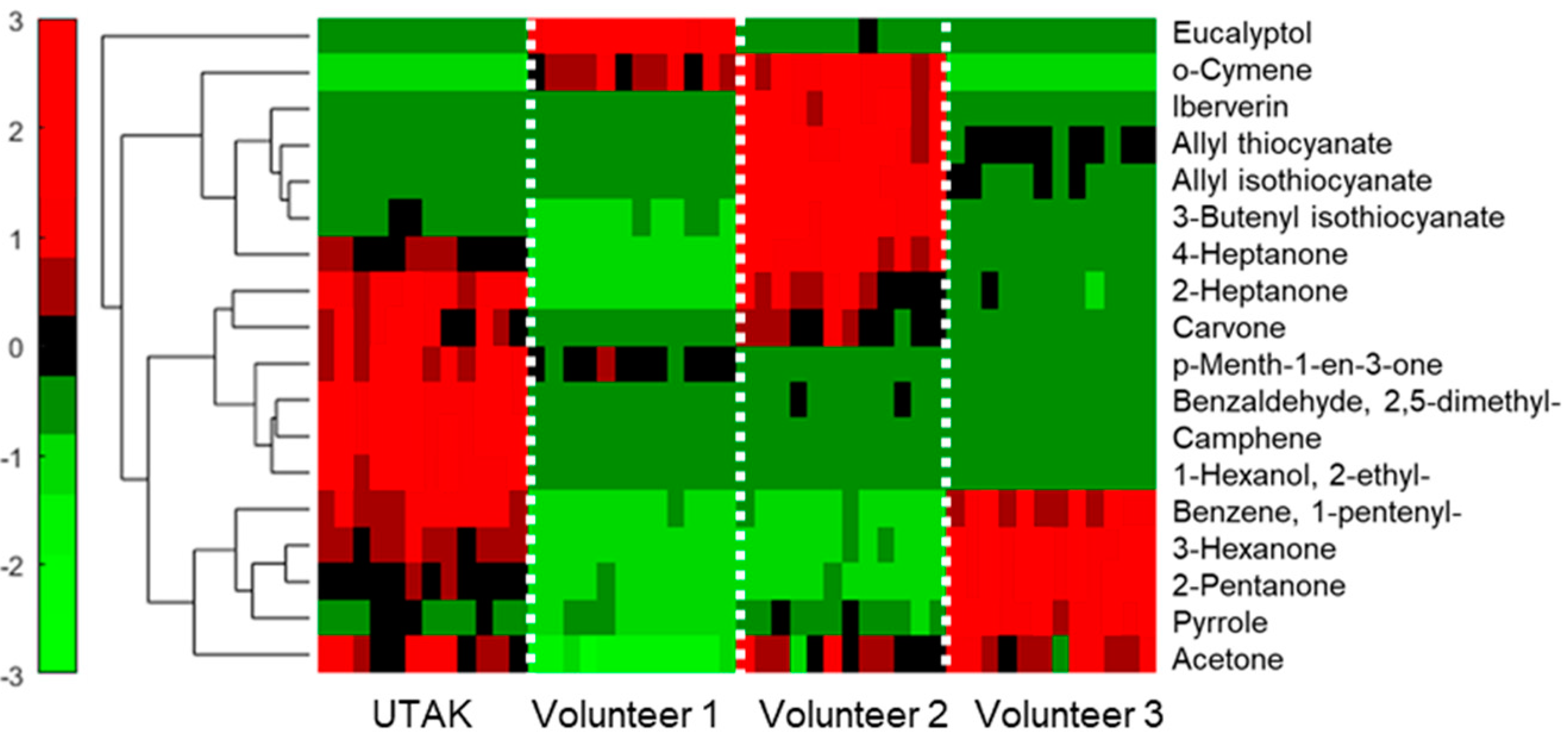
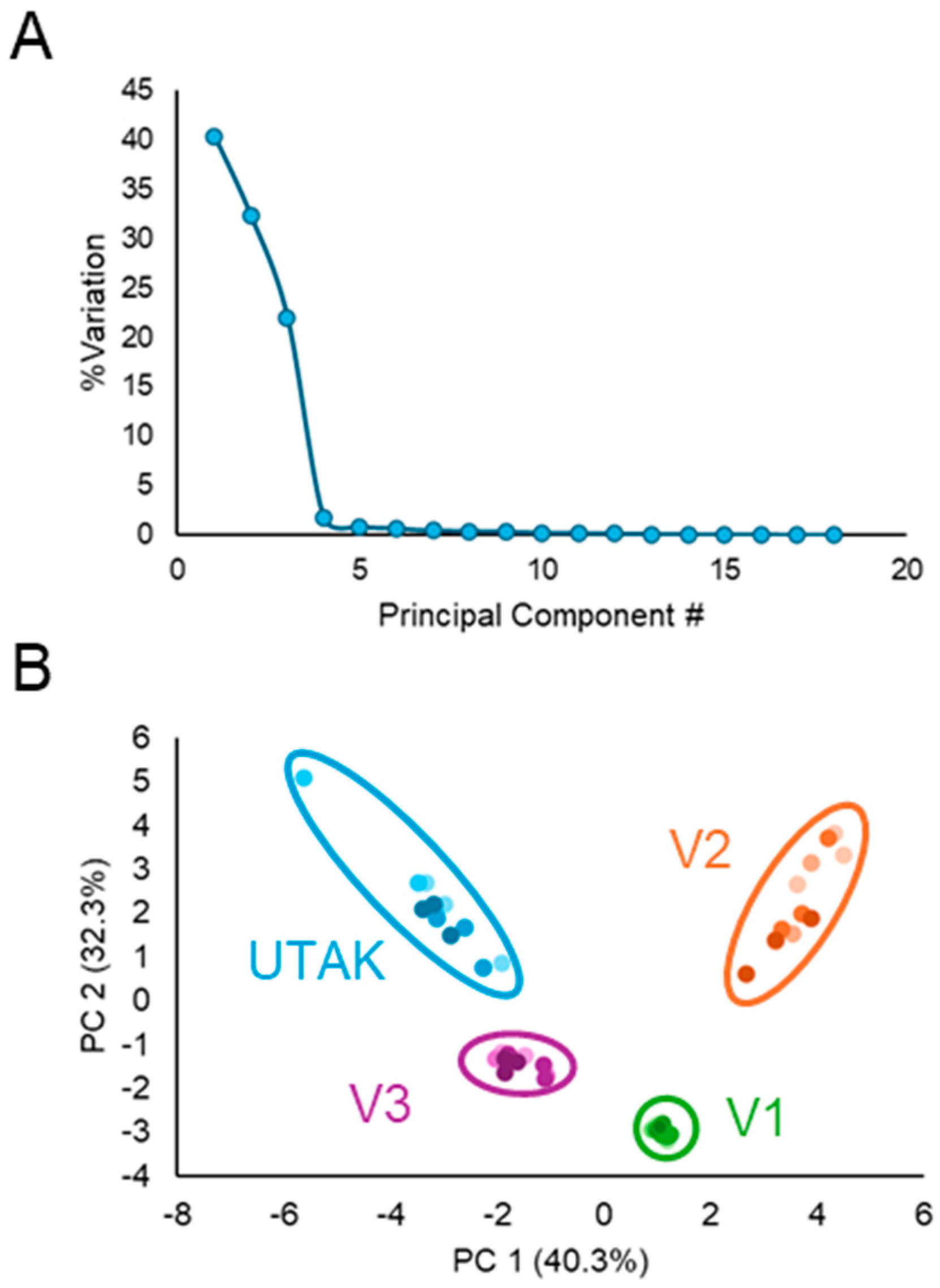

| VOCs | RT (minutes) | Base m/z | CAS# |
|---|---|---|---|
| Acetone | 0:46 | 43 | 67-64-1 |
| HAPSITE IS 1 | 1:17 | 69 | 729-81-7 |
| 2-Pentanone | 1:33 | 43 | 107-87-9 |
| Pyrrole | 2:09 | 67 | 109-97-7 |
| HAPSITE IS 2 | 3:47 | 117 | 344-04-7 |
| 4-Heptanone | 3:58 | 71 | 123-19-3 |
| 2-Heptanone | 4:16 | 58 | 110-43-0 |
| 1-Hexanol, 2-ethyl- | 6:52 | 57 | 104-76-7 |
| Benzene, 1-pentenyl- | 8:21 | 117 | 826-18-6 |
| Benzaldehyde, 2,5-dimethyl- | 9:09 | 134 | 5779-94-2 |
| Carvone | 9:27 | 82 | 99-49-0 |
| p-Menth-1-en-3-one | 9:33 | 82 | 89-81-6 |
| Camphene | 9:55 | 93 | 79-92-5 |
| VOCs | RT (minutes) | m/z | CAS# |
|---|---|---|---|
| Acetone | 0:46 | 43 | 67-64-1 |
| 2-Pentanone | 1:33 | 43 | 107-87-9 |
| Pyrrole | 2:09 | 67 | 109-97-7 |
| 3-Hexanone | 2:33 | 57 | 589-38-8 |
| Allyl thiocyanate | 3:32 | 99 | 764-49-8 |
| Allyl Isothiocyanate | 3:55 | 99 | 57-06-7 |
| 4-Heptanone | 3:57 | 71 | 123-19-3 |
| 2-Heptanone | 4:16 | 58 | 110-43-0 |
| 3-Butenyl isothiocyanate | 5:44 | 72 | 3386-97-8 |
| o-Cymene | 6:51 | 119 | 527-84-4 |
| 1-Hexanol, 2-ethyl- | 6:52 | 57 | 104-76-7 |
| Eucalyptol | 7:00 | 71 | 470-82-6 |
| Benzene, 1-pentenyl- | 8:21 | 117 | 826-18-6 |
| Benzaldehyde, 2,5-dimethyl- | 9:09 | 134 | 5779-94-2 |
| Carvone | 9:27 | 108 | 99-49-0 |
| p-Menth-1-en-3-one | 9:33 | 110 | 89-81-6 |
| Iberverin | 9:51 | 101 | 505-79-3 |
| Camphene | 9:55 | 93 | 79-92-5 |
Disclaimer/Publisher’s Note: The statements, opinions and data contained in all publications are solely those of the individual author(s) and contributor(s) and not of MDPI and/or the editor(s). MDPI and/or the editor(s) disclaim responsibility for any injury to people or property resulting from any ideas, methods, instructions or products referred to in the content. |
© 2025 by the authors. Licensee MDPI, Basel, Switzerland. This article is an open access article distributed under the terms and conditions of the Creative Commons Attribution (CC BY) license (https://creativecommons.org/licenses/by/4.0/).
Share and Cite
Woollam, M.; Eckerle, S.; Schulz, E.; Nishkaran, S.; Button, S.; Agarwal, M. Repurposing Portable Gas Chromatograph–Mass Spectrometers for Detecting Volatile Organic Compound Biomarkers in Urine Headspace. Separations 2025, 12, 118. https://doi.org/10.3390/separations12050118
Woollam M, Eckerle S, Schulz E, Nishkaran S, Button S, Agarwal M. Repurposing Portable Gas Chromatograph–Mass Spectrometers for Detecting Volatile Organic Compound Biomarkers in Urine Headspace. Separations. 2025; 12(5):118. https://doi.org/10.3390/separations12050118
Chicago/Turabian StyleWoollam, Mark, Serenidy Eckerle, Eray Schulz, Sahanaa Nishkaran, Sara Button, and Mangilal Agarwal. 2025. "Repurposing Portable Gas Chromatograph–Mass Spectrometers for Detecting Volatile Organic Compound Biomarkers in Urine Headspace" Separations 12, no. 5: 118. https://doi.org/10.3390/separations12050118
APA StyleWoollam, M., Eckerle, S., Schulz, E., Nishkaran, S., Button, S., & Agarwal, M. (2025). Repurposing Portable Gas Chromatograph–Mass Spectrometers for Detecting Volatile Organic Compound Biomarkers in Urine Headspace. Separations, 12(5), 118. https://doi.org/10.3390/separations12050118





